- Abstract
- Among winter/spring tomatoes, cherry tomato harvest volume (main data).
- Among winter/spring tomatoes, cherry tomato harvest volume (by prefecture).
- Among winter/spring tomatoes, the area planted with cherry tomatoes (main data).
- Among winter/spring tomatoes, the area planted with cherry tomatoes (by prefecture).
- Among winter/spring tomatoes, the volume of cherry tomatoes shipped is
- Reference
Abstract
Cherry tomatoes are gaining attention as a winter/spring tomato crop in Japan. According to 2022 data, the national yield is 101kt and the area under cultivation has reached a maximum of 1.17kha. In particular, Kumamoto had the largest shipping volume at 35.2kt, and has established itself as a tomato producing region. Past trends suggest that demand for cherry tomatoes is on the rise. This reflects consumers’ tendency to prioritize health and convenience, and to prefer small cherry tomatoes. In addition, advances in climatic conditions and technology mean that sufficient harvests are possible even in winter and spring. Given this background, it is expected that winter-spring tomato cultivation will continue to expand and production will continue to meet demand.
Among winter/spring tomatoes, cherry tomato harvest volume (main data).
In Japanese agriculture, the cultivation of winter/spring tomatoes is an important area, and among them, the yield of cherry tomatoes is attracting attention. Looking at data from 1990 to 2022, tomato yields have steadily increased. In particular, in 2021, a peak harvest of 102kt was recorded nationwide. However, it has since declined somewhat, and current harvest volumes are only 98.2% of their peak. This decline is likely due to several factors. For example, these include the effects of climate change and natural disasters, efficiency improvements due to advances in agricultural technology, and changes in demand. Another recent trend is an increase in demand for cherry tomatoes due to consumers becoming more health conscious and food culture becoming more diversified. Given this background, it is expected that winter-spring tomato production will continue to be adjusted in response to changes in demand and technological advances.
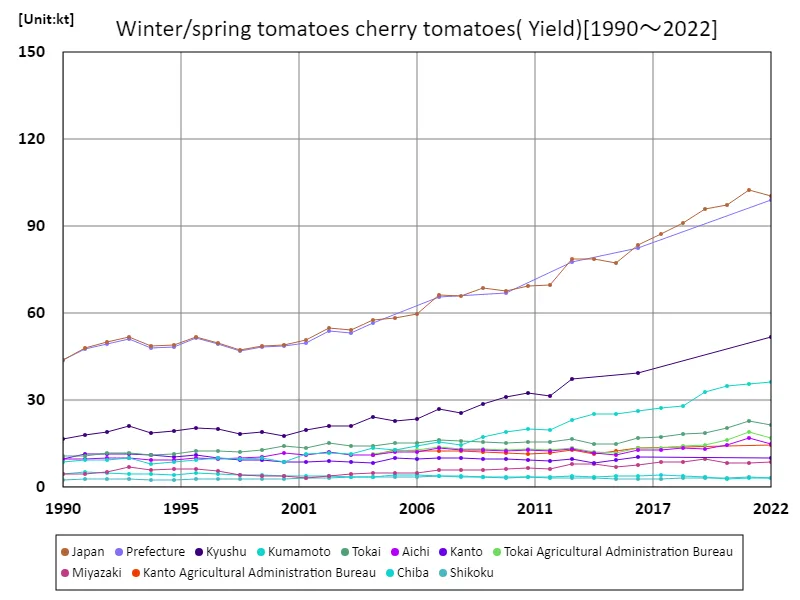

The maximum is 102kt[2021] of Japan, and the current value is about 98.2%
Among winter/spring tomatoes, cherry tomato harvest volume (by prefecture).
The fruit and vegetable harvest yields in Japanese agriculture vary from prefecture to prefecture. According to 2022 data, Kumamoto Prefecture recorded the largest harvest, with 36.4kt of the total. This figure is a new record high, demonstrating Kumamoto Prefecture’s position as the top producer of fruit and vegetable products. Kumamoto Prefecture is characterized by its suitable climatic conditions, abundant agricultural technology, and proactive agricultural policies. On the other hand, there is variation in harvest yields in other prefectures. This is due to differences in climate conditions and soil from region to region, as well as differences in major agricultural crops. Differences in agricultural policies and investment also affect yield differences across regions. Generally speaking, fruit vegetable harvests in Japan vary by region, but some regions, including Kumamoto Prefecture, boast high yields, and other regions also produce vegetables taking advantage of their own unique characteristics.
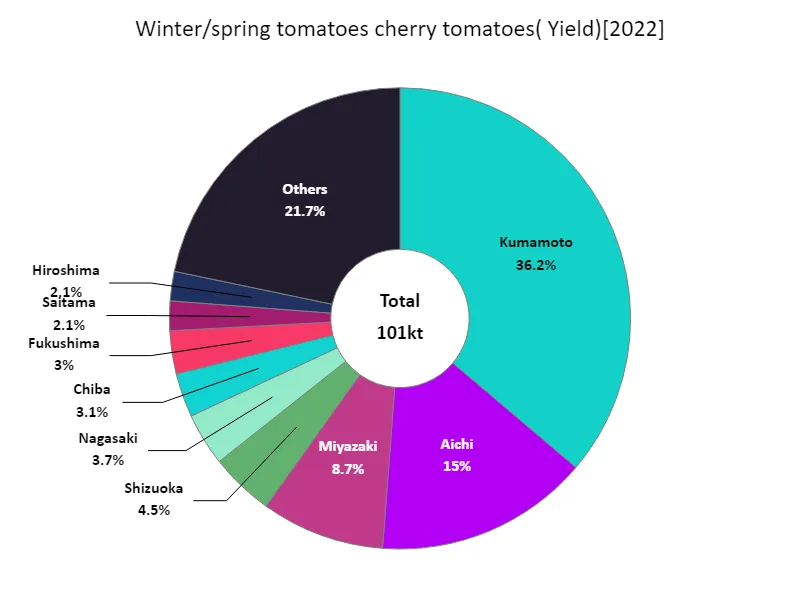

The maximum is 36.4kt of Kumamoto, the average is 2.14kt, and the total is 101kt
Among winter/spring tomatoes, the area planted with cherry tomatoes (main data).
The area planted to cherry tomatoes, a type of winter-spring tomato, in Japanese agriculture has been steadily increasing since 1990. The latest data shows that the total cultivated area nationwide is 1.17kha, the highest figure ever. This increase is largely due to changes in consumer demand. In recent years, interest in health and nutrition has increased, leading to an increased demand for nutritious vegetables such as cherry tomatoes. Changes in lifestyles in urban areas are also having an impact, increasing the demand for easy-to-eat vegetables such as cherry tomatoes. Advances in agricultural technology and improvements in cultivation methods have also contributed to the expansion of cultivated area. This allows for more efficient cultivation and improved productivity. Overall, the area cultivated with cherry tomatoes is on the rise, and is expected to continue to expand due to growing demand and technological advances.
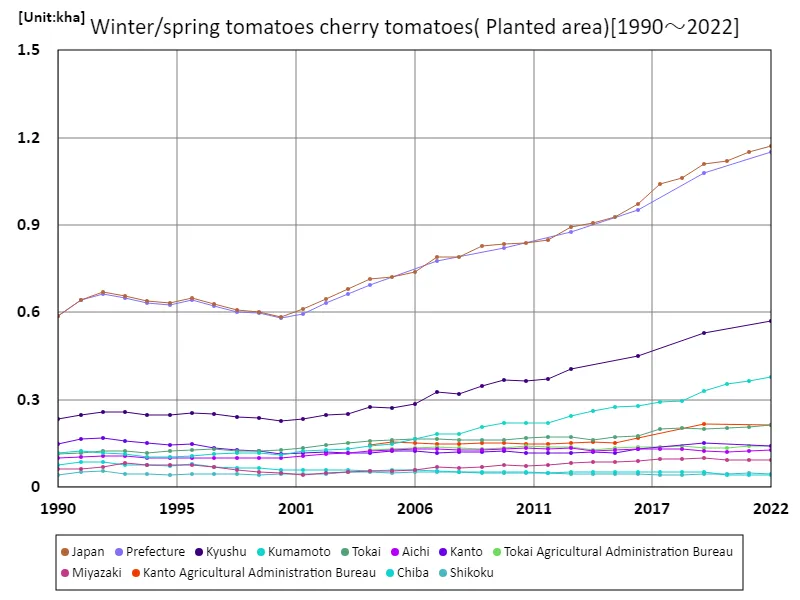

The maximum is the latest one, 1.17kha of Japan
Among winter/spring tomatoes, the area planted with cherry tomatoes (by prefecture).
The area of land cultivated with fruit and vegetables in Japanese agriculture varies from prefecture to prefecture. According to data from 2022, Kumamoto Prefecture recorded the highest overall area, achieving a planted area of 380 hectares. This figure is a new record high, indicating Kumamoto Prefecture’s lead in fruit and vegetable production. Kumamoto Prefecture is characterized by its suitable climatic conditions, abundant agricultural technology, and proactive agricultural policies. On the other hand, there is variation in the cultivated area in other prefectures. This is due to differences in climate and soil conditions in each region, as well as differences in the main crops. Differences in agricultural policies and investment also affect the differences in cultivated area across regions. Generally speaking, the area of land used to cultivate fruit vegetables in Japan varies by region, but some regions, including Kumamoto Prefecture, boast large areas of land, and other regions also produce vegetables taking advantage of their respective characteristics.
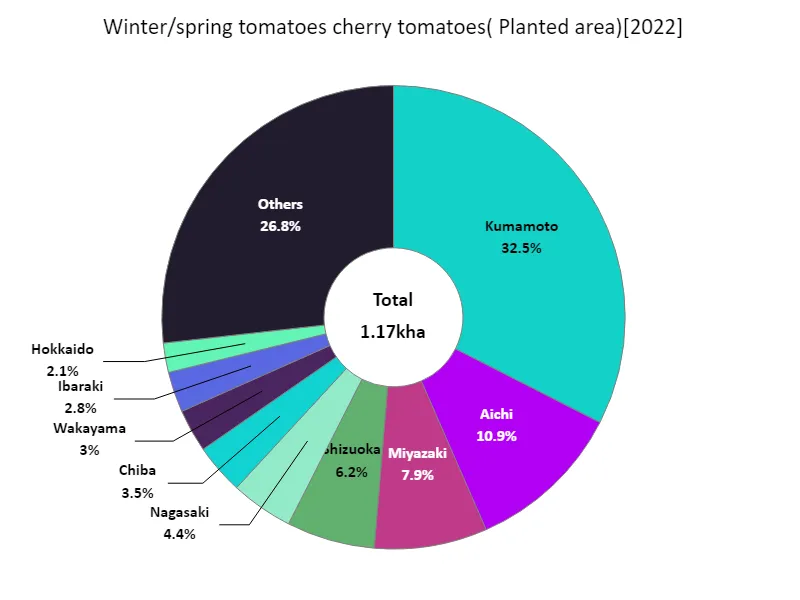

The maximum is 380ha of Kumamoto, the average is 24.9ha, and the total is 1.17kha
Among winter/spring tomatoes, the volume of cherry tomatoes shipped is
Kumamoto Prefecture has the highest overall shipping volume of cherry tomatoes, a type of winter-spring tomato in Japanese agriculture. According to data for 2022, Kumamoto Prefecture’s shipping volume was 35.2kt, the highest figure ever. The average shipment was 2.04kt, with an overall total of 96.1kt. These figures suggest that demand for cherry tomatoes is on the rise. In recent years, interest in health and nutrition has increased, leading to an increased demand for nutritious vegetables such as cherry tomatoes. Changes in lifestyles in urban areas are also having an impact, increasing the demand for easy-to-eat vegetables such as cherry tomatoes. In producing areas like Kumamoto Prefecture, favorable climatic conditions, advances in agricultural technology, and proactive agricultural policies have contributed to increased shipping volumes. In addition, production is also taking place in other regions to meet demand, and overall shipments are also on the rise. Given these circumstances, it is expected that shipments of cherry tomatoes will continue to increase and production will continue to meet demand.
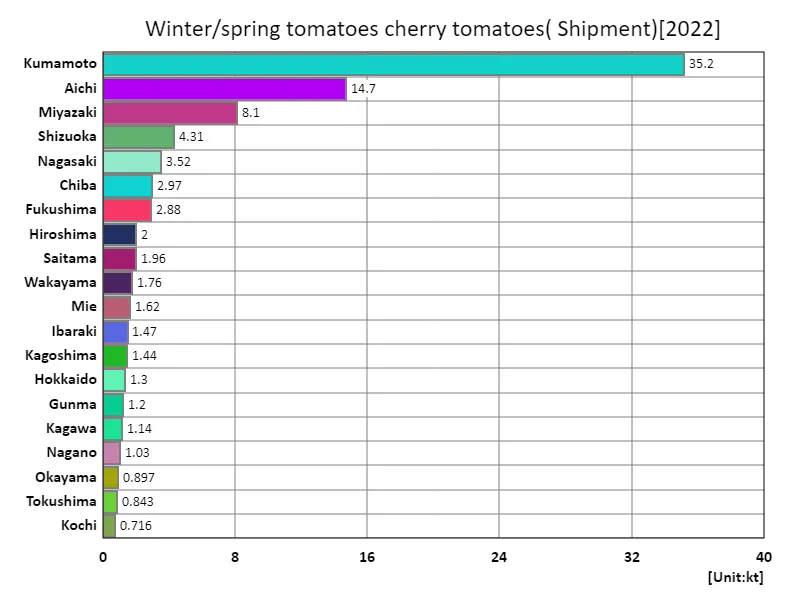

The maximum is 35.2kt of Kumamoto, the average is 2.04kt, and the total is 96.1kt
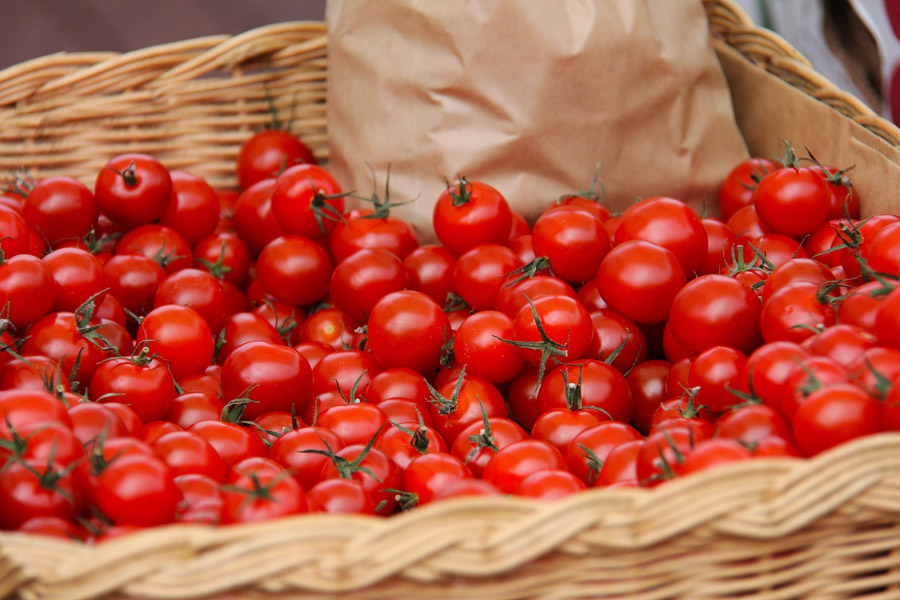


Comments